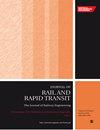通过考虑轮轨弹性变形预测高速列车的车轮磨损情况
IF 2.1
4区 工程技术
Q3 ENGINEERING, CIVIL
Proceedings of the Institution of Mechanical Engineers Part F-Journal of Rail and Rapid Transit
Pub Date : 2024-03-09
DOI:10.1177/09544097241239089
引用次数: 0
摘要
轮轨几何参数对确定高速列车的车轮磨损至关重要。在轮轨载荷作用下,车轮和钢轨都会发生弹性变形,从而影响轮轨接触关系,并进一步影响车轮轮廓及其演变。在这项研究中,对一列运行速度为 250 km/h 的高速列车进行了实地测试,并在一个重修周期内连续测量了磨损的车轮轮廓和磨损曲线。随后,使用基于集成 USFD 磨损算法的车轮磨损预测模型建立了车辆动力学模型。在该模型中,考虑了轮轨接触的有限元模型。通过有限元方法确定轮轨的弹性变形,从而获得轮轨的几何参数,该方法考虑了三个参数的影响:轨距、轮对的背对背空间和轨道倾斜度。在考虑轮轨弹性变形后,轨距从 1435 毫米减小到 1434.5 毫米,背对背空间从 1353 毫米变为 1352.3 毫米,轨道倾角从 1:40 变为约 1:37。最后,对模拟结果和实验结果进行了比较,结果表明,车辆行驶 15 万公里后,轮轨弹性变形对车轮磨损有显著影响。考虑弹性变形后的磨损深度和轮轨等效锥度更接近测量结果。本文章由计算机程序翻译,如有差异,请以英文原文为准。
Wheel wear prediction for high-speed trains by considering wheel-rail elastic deformation
Wheel-rail geometric parameters are crucial for determining wheel wear in high-speed trains. Under the action of a wheel-rail load, both the wheel and rail suffer elastic deformation, which affects the wheel-rail contact relationship and further influences the wheel profile and its evolution. In this study, a field test was conducted on a high-speed train operating at 250 km/h, and the worn wheel profiles and wear curves were continuously measured for one reprofiling cycle. Subsequently, a vehicle dynamics model is built using a wheel wear prediction model based on the integrated USFD wear algorithm. In this model, the finite element model of the wheel-rail contact is considered. The wheel-rail geometric parameters are obtained by determining their elastic deformation through the finite element method, which considers the effect of three parameters: the track gauge, back-to-back space of the wheelset, and rail cant. After considering the wheel-rail elastic deformation, the track gauge decreases from 1435 to 1434.5 mm, the back-to-back space varies from 1353 to 1352.3 mm, and the rail cant changes from 1:40 to approximately 1:37. Finally, the simulation and experimental results are compared, revealing that the wheel-rail elastic deformation has a significant impact on the wheel wear after the vehicle travels 150,000 km. The wear depth and wheel-rail equivalent conicity after considering the elastic deformation are closer to the measured results.
求助全文
通过发布文献求助,成功后即可免费获取论文全文。
去求助
来源期刊

CiteScore
4.80
自引率
10.00%
发文量
91
审稿时长
7 months
期刊介绍:
The Journal of Rail and Rapid Transit is devoted to engineering in its widest interpretation applicable to rail and rapid transit. The Journal aims to promote sharing of technical knowledge, ideas and experience between engineers and researchers working in the railway field.
 求助内容:
求助内容: 应助结果提醒方式:
应助结果提醒方式:


